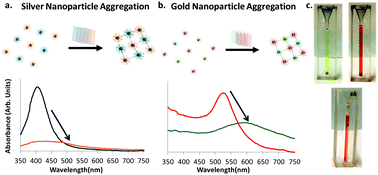Researchers from Cornell University have developed an assay for the multiplexed detection of Kaposi’s sarcoma-associated herpesvirus (KSHV, a precursor to an infectious type of cancer found mainly in developing countries and difficult to diagnose) and bacillary angiomatosis (BA) based on the colorimetric properties of thiol-modified oligonucleotide-gold and silver nanoparticle conjugates.

The authors propose that this simple strategy for DNA detection could be integrated into a microfluidic device for rapid point-of-care detection of KSHV.
By Dr Lee Barrett
Read the full details of this exciting research published in Nanoscale:
Multiplexed colorimetric detection of Kaposi’s sarcoma associated herpesvirus and Bartonella DNA using gold and silver nanoparticles
Matthew Mancuso, Li Jiang, Ethel Cesarman and David Erickson
DOI: 10.1039/C3NR33492A










